Environmental Life Cycle Impacts of Automotive Batteries Based on a Literature Review
Abstract
1. Introduction
2. Methods
- (1)
- General description of the LCA study like authors and year of publication
- (2)
- LCA approaches used and tools like the background database, sensitivity variables, and assessed impact categories
- (3)
- Characteristics of the assessed battery packs like the capacity, weight, specific energy, lifespan, and material/component composition
- (4)
- Qualified and quantified the environmental impact of the battery production for the primary energy consumption and GHG emissions, split into battery components and production stages
- (5)
- End-of-life treatment like recycling method, recycling rate, qualified and quantified the environmental impacts for the primary energy consumption and GHG emissions, and positive benefits from battery recycling processes
- (6)
- Qualified and quantified the environmental impact of the whole battery life cycle
- (7)
- Evaluation of further environmental impact categories
3. Results and Discussion
3.1. General Description of Investigated LCAs
3.2. Used LCA Approaches and Data Sources
3.3. Assessed Battery Characteristics
3.4. Environmental Impact of Battery Production
3.4.1. Major Environmental Contributors in Battery Production
3.4.2. Collected Numerical Data for Battery Production
3.4.3. Numerical Results for Material Production
3.4.4. Numerical Results for Cell and Pack Manufacturing
3.4.5. Battery Production Impact per km for EV Use
3.5. Environmental Impact of Battery Recycling
3.5.1. Major Environmental Contributors to Recycling
3.5.2. Numerical Results for Recycling/Reuse
3.6. Total Numerical Results for the Battery Life Cycle
3.7. Other Impact Categories
3.7.1. Introduction
3.7.2. Resource Depletion
3.7.3. Acidification
3.7.4. Ecotoxicity
3.7.5. Eutrophication
3.7.6. Human Toxicity
3.7.7. Ozone Depletion
3.7.8. Air Pollutants
3.7.9. Photochemical Ozone
3.7.10. Numerical Results per Impact Category from the Literature Review
4. Recommendations and Conclusions
- The inclusion of further impact categories besides the primary energy demand and GHG emissions
- Inclusion and assessment of recycling and second-life applications
- Inclusion of the battery lifetime in estimations based on cycle life and replacement from battery packs, if needed
- Statement of the detailed material mass composition and the component mass composition of the battery pack
- Statement of relevant technological specifications like battery type, capacity, weight, and specific energy of the battery pack
- Statement of GHG emissions (total and per functional unit) for each relevant material like aluminum and the active material, as well as electricity mix GHG emissions
- Usage and gathering of primary data from industrial-scale production plants and comparing different production processes
- Reduction of dependence on few LCAs with primary data and increased critical reviews of data sources
- Consideration of production scale and the shares of electricity and heat and by which energy source heat is provided
- Assessment of material processing impacts and the influence of the electricity mix and different processes in more locations like for Chinese production
- Performing of consequential LCAs to include indirect life cycle impacts and to compare the impacts of a higher amount of produced possibly larger batteries in various scenarios like a growing number of large BEVs or growing car sales
Author Contributions
Funding
Acknowledgments
Conflicts of Interest
Appendix A
| No. | Title | Organization/Authors | Year of Publication |
|---|---|---|---|
| 1 | Application of Life-Cycle Assessment to Nanoscale Technology: Lithium-Ion Batteries for Electric Vehicles [42] | EPA—United States Environmental Protection Agency; Amarakoon S., Smith J. and Segal B. | 2013 |
| 2 | Contribution of Li-Ion Batteries to the Environmental Impact of Electric Vehicles [4] | Technology and Society Laboratory, Swiss Federal Laboratories for Materials Science and Technology; Notter D., Gauch M., Widmer R., Wager P., Stamp A., Zah R. and Althaus H.-J. | 2010 |
| 3 | The Life Cycle Energy Consumption and Greenhouse Gas Emissions from Lithium-Ion Batteries [11] | IVL Swedish Environmental Research Institute; Romare M. and Dahllöf L. | 2017 |
| 4 | Update of Life Cycle Analysis of Lithium-ion Batteries in the GREET Model [43] | Argonne National Laboratory; Dai Q., Dunn J., Kelly L.-C., and Elgowainy A. | 2017 |
| 5 | The size and range effect: lifecycle greenhouse gas emissions of electric vehicles [13] | Norwegian University of Science and Technology; Ellingsen L., Singh B. and Strømman A. | 2016 |
| 6 | Comparative Study on Life Cycle CO2 Emissions from the Production of Electric and Conventional Vehicles in China [14] | Tsinghua University; Qiao Q., Zhao F., Liu Z., Jiang S. and Hao H. | 2017 |
| 7 | Life Cycle Analysis Summary for Automotive Lithium-Ion Battery Production and Recycling [15] | Argonne National Laboratory; Dunn J., Gaines L., Kelly J. and Gallagher K. | 2016 |
| 8 | Plug-in vs. wireless charging: Life cycle energy and greenhouse gas emissions for an electric bus system [16] | University of Michigan; Bi Z., Song L., De Kleine R., Mi C. and Keoleian G. | 2015 |
| 9 | Electric vehicle life cycle analysis and raw material availability [17] | Transport and Environment | 2017 |
| 10 | Lithium Ion Battery Recycling Technology 2015—Current State and Future Prospects [44] | Chalmers University of Technology; Kushnir D. | 2015 |
| 11 | Impact of recycling on energy consumption and greenhouse gas emissions from electric vehicle production: The China 2025 case [18] | Tsinghua University; Hao H., Qiao Q., Liu Z. and Zhao F. | 2017 |
| 12 | Comparison of the Environmental impact of five Electric Vehicle Battery technologies using LCA [19] | Vrije Universiteit Brussel, Université Libre de Bruxelles, Erasmus Hogeschool Brussel; Matheys J., Timmermans J.-M., Van Autenboer W., Van Mierlo J., Maggetto G., Meyer S., De Groof A., Hecq W. and Van den Bossche P. | 2009 |
| 13 | Cleaner Cars from Cradle to Grave—How Electric Cars Beat Gasoline Cars on Lifetime Global Warming Emissions [20] | Union of Concerned Scientists; Nealer R., Reichmuth D. and Anair D. | 2015 |
| 14 | Ökobilanzierung der Elektromobilität—Themen und Stand der Forschung [21] | Modellregionen Elektromobilität, Wuppertal Institut für Klima, Umwelt, Energie GmbH; Ritthoff M. and Schallaböck K. | 2012 |
| 15 | Lithium-Ion Battery Production and Recycling Materials Issues (Presentation) [22] | Argonne National Laboratory; Gaines L. and Dunn J. | 2015 |
| 16 | Research for TRAN Committee—Battery-powered electric vehicles: market development and lifecycle emissions—Part 2—Resources, energy, and lifecycle greenhouse gas emission aspects of electric vehicles [23] | European Parliament; Directorate-General for Internal Policies; Policy Department B.: Structural and Cohesion Policies; Committee on Transport and Tourism; Thomas M. Ellingsen L. and Hung, C. | 2018 |
| 17 | Effects of battery manufacturing on electric vehicle life-cycle greenhouse gas emissions [24] | icct—The International Council on Clean Transportation; Lutsey N. and Hall D. | 2018 |
| 18 | Aktualisierung Umweltaspekte von Elektroautos [25] | treeze—fair life cycle thinking, Frischknecht R., Messmer A. and Stolz P. | 2018 |
| 19 | Klimabilanz von Elektroautos—Einflussfaktoren und Verbesserungspotenzial [26] | Agora Verkehrswende, ifeu—Institut für Energie- und Umweltforschung; Helms H., Kämper C., Biemann K., Lambrecht U., Jöhrens J. and Meyer K. | 2019 |
| 20 | Techno-economic and environmental assessment of stationary electricity storage technologies for different time scales [27] | Lucerne University of Applied Sciences and Arts, Paul Scherrer Institute, University of Geneva; Abdon A., Zhang X., Parra D., Patel M., Bauer C. and Worlitschek J. | 2017 |
| 21 | Ökologische und ökonomische Performance stationärer Li-Ion-Batteriespeicher [28] | Karlsruher Institut für Technologie, Baumann M., Peters J. and Weil M. | 2018 |
| 22 | Providing a common base for life cycle assessments of Li-Ion batteries [29] | Helmholtz Institute Ulm (HIU), ITAS—Institute for Technology Assessment and Systems Analysis, Karlsruhe Institute of Technology (KIT); Peters J. and Weil M. | 2018 |
| 23 | Life cycle assessment of lithium-ion batteries for plug-in hybrid electric vehicles—Critical issues [6] | Swerea IVF AB; Zackrisson M., Avellan L. and Orlenius J. | 2010 |
| 24 | Environmental consequences of the use of batteries in low carbon systems: The impact of battery production [30] | University of Bath; McManus M.C. | 2012 |
| 25 | Environmental performance of electricity storage systems for grid applications, a life cycle approach [31] | Vrije Universiteit Brussel, Laborelec; Oliveira L., Messagie M., Mertens J., Laget H., Coosemans T. and Van Mierlo J. | 2015 |
| 26 | Energy analysis of batteries in photovoltaic systems. Part I: Performance and energy requirements [32] | University of Kalmer, Chalmers University of Technology; Rydh C. and Sandén B. | 2005 |
| 27 | Power-to-What?—Environmental assessment of energy storage systems [33] | RWTH Aachen University; Sternberg A. and Bardow A. | 2015 |
| 28 | Environmental impacts of Lithium Metal Polymer and Lithium-ion stationary batteries [45] | Université de Sherbrooke, Institut de recherche d’Hydro-Québec; Vandepaer L., Cloutier J. and Amor B. | 2017 |
| 29 | Life Cycle Assessment of a Lithium-Ion Battery Vehicle Pack [8] | Norwegian University of Science and Technology, CIRAIG, Tel-Tek; Ellingsen L., Majeau-Bettez G., Singh B., Srivastva A, Valøen L. and Strømman H. | 2014 |
| 30 | Cradle-to-Gate Emissions from a Commercial Electric Vehicle Li-Ion Battery: A Comparative Analysis [46] | Ford Motor Company, LG Chem Research Park; Kim H., Wallington T., Arsenault R., Bae C., Ahn S. and Lee J. | 2016 |
| 31 | Manufacturing energy analysis of lithium ion battery pack for electric vehicles [47] | Case Western Reserve University, University of Wisconsin; Yuan C., Deng Y., Li T. and Yang F. | 2017 |
| 32 | Life Cycle Analysis of Lithium-Ion Batteries for Automotive Applications [9] | Argonne National Laboratory; Dai Q., Kelly J., Gaines L. and Wang M. | 2019 |
| 33 | Eco-Efficiency of a Lithium-Ion Battery for Electric Vehicles: Influence of Manufacturing Country and Commodity Prices on GHG Emissions and Costs [48] | Vrije Universiteit Brussel, Flanders Make, CIDETEC; Philippot M., Alvarez G., Ayerbe E., Van Mierlo J. and Messagie M. | 2019 |
| 34 | GHG Emissions from the Production of Lithium-Ion Batteries for Electric Vehicles in China [34] | Tsinghua University; Hao H., Mu Z., Jiang S., Liu Z. and Zhao F. | 2017 |
| 35 | Quantifying the environmental impact of a Li-rich high-capacity cathode material in electric vehicles via life cycle assessment [49] | Beijing Institute of Technology, Beijing Forestry University; Wang Y., Yu Y., Huang K., Chen B., Deng W. and Yao Y. | 2017 |
| 36 | Comparative life cycle assessment of lithium-ion batteries with lithium metal, silicon nanowire, and graphite anodes [35] | Peking University Shenzhen Graduate School; Wu Z. and Kong D. | 2018 |
| 37 | Life Cycle Environmental Assessment of Lithium-Ion and Nickel Metal Hydride Batteries for Plug-In Hybrid and Battery Electric Vehicles [7] | Norwegian University of Science and Technology; Majeau-Bettez G., Hawkins T. and Strømman A. | 2011 |
| 38 | Impact of Recycling on Cradle-to-Gate Energy Consumption and Greenhouse Gas Emissions of Automotive Lithium-Ion Batteries [5] | Argonne National Laboratory; Dunn J., Gaines L., Sullivan J. and Wang M. | 2012 |
| 39 | The environmental impact of Li-Ion batteries and the role of key parameters—A review [36] | Karlsruhe Institute for Technology; Peters J., Baumann M., Zimmermann B., Braun J. and Weil M. | 2017 |
| 40 | Identifying key assumptions and differences in life cycle assessment studies of lithium-ion traction batteries with focus on greenhouse gas emissions [37] | Norwegian University of Science and Technology; Ellingsen L., Hung C. and Strømman A. | 2017 |
| 41 | Life cycle assessment of lithium sulfur battery for electric vehicles [50] | Soochow University, University of Wisconsin, Case Western Reserve University; Deng Y., Li J., Li T., Gao X. and Yuan C. | 2017 |
| 42 | Life cycle assessment of future electric and hybrid vehicles: A cradle-to-grave systems engineering approach [38] | University College London, Università di Salerno; Tagliaferri C., Evangelisti S., Acconia F., Domenech T., Ekins P., Barletta D. and Lettieri P. | 2016 |
| 43 | Effects of battery chemistry and performance on the life cycle greenhouse gas intensity of electric mobility [39] | University of California; Ambrose H. and Kendall A. | 2016 |
| 44 | Comparative environmental assessment of alternative fueled vehicles using a life cycle assessment [40] | Vrije Universiteit Brussel; Van Mierlo J., Messagie M. and Rangaraju S. | 2017 |
| 45 | Energy and environmental assessment of a traction lithium-ion battery pack for plug-in hybrid electric vehicles [51] | University of Palermo, European Commission, Politecnico di Torino; Cusenza M., Bobba S., Ardente F., Cellura M. and Di Persio F. | 2019 |
| 46 | Prospective LCA of the production and EoL recycling of a novel type of Li-ion battery for electric vehicles [52] | Oxford Brookes University; Raugei M. and Winfield P. | 2019 |
| 47 | PEFCR—Product Environmental Footprint Category Rules for High Specific Energy Rechargeable Batteries for Mobile Applications [53] | Recharge; Siret C., Tytgat J., Ebert T., Mistry M., Thirlaway C., Schutz B., Xhantopoulos D., Wiaux J.-P., Chanson C., Tomboy W., Pettit C., Gediga J., Bonell M., Carrillo V. | 2018 |
| 48 | Preparatory Study on Ecodesign and Energy Labelling of Batteries under FWC ENER/C3/2015-619-Lot 1 [54] | European Union, VITO, Fraunhofer, Viegand Maagøe; Lam W.C., Peeters K., Tichelen P. V. | 2019 |
| 49 | Globally regional life cycle analysis of automotive lithium-ion nickel manganese cobalt batteries [10] | Argonne National Laboratory; Kelly J., Dai Q., Wang M. | 2020 |
| 50 | Lithium-Ion Vehicle Battery Production—Status 2019 on Energy Use, CO2 Emissions, Use of Metals, Products Environmental Footprint, and Recycling [12] | IVL Swedish Environmental Research Institute; Emilsson E., Dahllöf L. | 2019 |
| Battery Production | Recycling Impact | Reduction Potential | |||||||||
|---|---|---|---|---|---|---|---|---|---|---|---|
| Per kWh_bc | Q25 | Q50 | Q75 | Q25 | Q50 | Q75 | Q25 | Q50 | Q75 | ||
| Energy | Primary energy demand | kWh | 1.98 × 102 | 2.84 × 102 | 5.19 × 102 | 6.68 × 101 | 7.64 × 101 | 7.75 × 101 | −5.83 × 101 | −9.04 × 101 | −1.00 × 102 |
| Global warming | GWP | kg CO2-eq | 7.06 × 101 | 1.20 × 102 | 1.75 × 102 | 2.93 | 5.65 | 1.15 × 101 | −1.65 × 101 | −2.60 × 101 | −3.16 × 101 |
| Resource depletion | ADP | kg Sb-eq | 4.86 × 10−2 | 5.93 × 10−2 | 4.22 × 10−1 | 8.14 × 10−5 | 8.16 × 10−5 | 8.20 × 10−5 | −1.12 × 10−3 | −4.73 × 10−2 | −1.19 × 10−1 |
| Water depletion | m3 | 2.37 × 10−1 | 5.62 × 10−1 | 5.70 × 10−1 | n.d. | n.d. | n.d. | n.d. | n.d. | n.d. | |
| FDP | kg oil-eq | 4.02 × 101 | 5.08 × 101 | 6.89 × 101 | n.d. | 1.99 | n.d. | n.d. | n.d. | n.d. | |
| MDP | kg Fe-eq | 9.10 × 101 | 9.99 × 101 | 1.51 × 102 | n.d. | 2.17 × 10−1 | n.d. | n.d. | n.d. | n.d. | |
| Acidification | AP | kg H+ Mol-eq | 1.50 | 2.33 | 4.41 | 8.60 × 10−2 | 8.63 × 10−2 | 8.70 × 10−2 | −5.54 × 10−1 | −5.55 × 10−1 | −3.73 |
| TAP | kg SO2-eq | 1.77 | 2.03 | 2.65 | n.d. | 5.42 × 10−2 | n.d. | n.d. | n.d. | n.d. | |
| Ecotoxicity | FWAE | kg 1,4-DB-eq | 8.48 | 9.61 | 9.91 | n.d. | 1.59 × 10−1 | n.d. | n.d. | n.d. | n.d. |
| MAE | kg 1,4-DB-eq | 9.42 | 1.04 × 101 | 1.07 × 101 | n.d. | 1.46 × 10−1 | n.d. | n.d. | n.d. | n.d. | |
| TE | kg 1,4-DB-eq | 4.45 × 10−2 | 4.95 × 10−2 | 5.15 × 10−2 | n.d. | 1.18 × 10−2 | n.d. | n.d. | n.d. | n.d. | |
| Eutrophication | EP | kg N-eq | 9.26 × 10−3 | 8.21 × 10−2 | 2.08 × 10−1 | n.d. | n.d. | n.d. | −1.91 × 10−3 | −9.80 × 10−3 | −4.86 × 10−2 |
| MEP | kg N-eq | 1.37 × 10−1 | 2.41 × 10−1 | 3.00 × 10−1 | 9.71 × 10−3 | 1.25 × 10−2 | 1.26 × 10−2 | −1.67 × 10−1 | −1.67 × 10−1 | −1.67 × 10−1 | |
| TETP | mole N-eq | 1.23 | 2.12 | 4.96 | 1.11 × 10−1 | 1.12 × 10−1 | 1.13 × 10−1 | −4.39 × 10−1 | −4.39 × 10−1 | −4.40 × 10−1 | |
| FEP | kg P-eq | 1.60 × 10−1 | 1.83 × 10−1 | 2.95 × 10−1 | 9.06 × 10−3 | 1.06 × 10−2 | 1.06 × 10−2 | −2.03 × 10−2 | −3.69 × 10−2 | −3.70 × 10−2 | |
| Human toxicity | HTP | kg 1,4-DB-eq | 1.53 × 102 | 2.50 × 102 | 3.82 × 102 | n.d. | 4.01 | n.d. | n.d. | n.d. | n.d. |
| Ozone | ODP | kg CFC 11-eq | 1.10 × 10−5 | 1.16 × 10−4 | 1.07 × 10−3 | 2.83 × 10−6 | 3.62 × 10−6 | 3.62 × 10−6 | −1.25 × 10−6 | −2.21 × 10−6 | −2.23 × 10−6 |
| Air pollutants | PMFP (2.5) | kg PM2.5-eq | 1.39 × 10−1 | 1.62 × 10−1 | 1.99 × 10−1 | 1.18 × 10−2 | 1.18 × 10−2 | 1.18 × 10−2 | −4.40 × 10−2 | −4.41 × 10−2 | −4.40 × 10−2 |
| PMFP (10) | kg PM10-eq | 4.57 × 10−1 | 5.85 × 10−1 | 8.13 × 10−1 | n.d. | 1.50 × 10−2 | n.d. | n.d. | n.d. | n.d. | |
| SOx | g | 8.30 × 102 | 9.60 × 102 | 1.20 × 103 | n.d. | n.d. | n.d. | n.d. | n.d. | n.d. | |
| NOx | g | 1.00 × 102 | 1.10 × 102 | 1.20 × 102 | n.d. | n.d. | n.d. | n.d. | n.d. | n.d. | |
| PM10 | g | 8.03 × 101 | 1.13 × 102 | 1.45 × 102 | n.d. | n.d. | n.d. | n.d. | n.d. | n.d. | |
| Photochemical ozone | POFP | kg NMVOC | 6.41 × 10−1 | 6.80 × 10−1 | 9.91 × 10−1 | 2.98 × 10−2 | 3.20 × 10−2 | 3.23 × 10−2 | −1.36 × 10−1 | −1.36 × 10−1 | −1.37 × 10−1 |
References
- U.S. Environmental Protection Agency (EPA). Life Cycle Assessment: Principles and Practice; US Environmental Protection Agency: Cincinnati, OH, USA, 2006.
- International Organization for Standardization (ISO). ISO 14040:2006. Available online: https://www.iso.org/cms/render/live/en/sites/isoorg/contents/data/standard/03/74/37456.html (accessed on 8 July 2020).
- IEA. Global EV Outlook 2020; IEA: Paris, France, 2020. [Google Scholar]
- Notter, D.A.; Gauch, M.; Widmer, R.; Wäger, P.; Stamp, A.; Zah, R.; Althaus, H.-J. Contribution of Li-Ion Batteries to the Environmental Impact of Electric Vehicles. Environ. Sci. Technol. 2010, 44, 6550–6556. [Google Scholar] [CrossRef]
- Dunn, J.B.; Gaines, L.; Sullivan, J.; Wang, M.Q. Impact of Recycling on Cradle-to-Gate Energy Consumption and Greenhouse Gas Emissions of Automotive Lithium-Ion Batteries. Environ. Sci. Technol. 2012, 46, 12704–12710. [Google Scholar] [CrossRef]
- Zackrisson, M.; Avellán, L.; Orlenius, J. Life cycle assessment of lithium-ion batteries for plug-in hybrid electric vehicles—Critical issues. J. Clean. Prod. 2010, 18, 1519–1529. [Google Scholar] [CrossRef]
- Majeau-Bettez, G.; Hawkins, T.R.; Strømman, A.H. Life Cycle Environmental Assessment of Lithium-Ion and Nickel Metal Hydride Batteries for Plug-In Hybrid and Battery Electric Vehicles. Environ. Sci. Technol. 2011, 45, 4548–4554. [Google Scholar] [CrossRef] [PubMed]
- Ellingsen, L.A.-W.; Majeau-Bettez, G.; Singh, B.; Srivastava, A.K.; Valøen, L.O.; Strømman, A.H. Life Cycle Assessment of a Lithium-Ion Battery Vehicle Pack: LCA of a Li-Ion Battery Vehicle Pack. J. Ind. Ecol. 2014, 18, 113–124. [Google Scholar] [CrossRef]
- Dai, Q.; Kelly, J.C.; Gaines, L.; Wang, M. Life Cycle Analysis of Lithium-Ion Batteries for Automotive Applications. Batteries 2019, 5, 48. [Google Scholar] [CrossRef]
- Kelly, J.C.; Dai, Q.; Wang, M. Globally regional life cycle analysis of automotive lithium-ion nickel manganese cobalt batteries. Mitig. Adapt. Strateg. Glob. Change 2020, 25, 371–396. [Google Scholar] [CrossRef]
- Romare, M.; Dahllöf, L. The Life Cycle Energy Consumption and Greenhouse Gas Emissions from Lithium-Ion Batteries; IVL Swedish Environmental Research Institute: Stockholm, Sweden, 2017. [Google Scholar]
- Emilsson, E.; Dahllöf, L. Lithium-Ion Vehicle Battery Production Status 2019 on Energy Use, CO2 Emissions, Use of Metals, Products Environmental Footprint, and Recycling; IVL Swedish Environmental Research Institute: Stockholm, Sweden, 2019. [Google Scholar]
- Ellingsen, L.A.-W.; Singh, B.; Strømman, A.H. The size and range effect: Lifecycle greenhouse gas emissions of electric vehicles. Environ. Res. Lett. 2016, 11, 054010. [Google Scholar] [CrossRef]
- Qiao, Q.; Zhao, F.; Liu, Z.; Jiang, S.; Hao, H. Comparative Study on Life Cycle CO2 Emissions from the Production of Electric and Conventional Vehicles in China. Energy Procedia 2017, 105, 3584–3595. [Google Scholar] [CrossRef]
- Dunn, J.B.; Gaines, L.; Kelly, J.C.; Gallagher, K.G. Life Cycle Analysis Summary for Automotive Lithium-Ion Battery Production and Recycling. In REWAS 2016; Kirchain, R.E., Blanpain, B., Meskers, C., Olivetti, E., Apelian, D., Howarter, J., Kvithyld, A., Mishra, B., Neelameggham, N.R., Spangenberger, J., Eds.; Springer International Publishing: Cham, Switzerland, 2016; pp. 73–79. [Google Scholar] [CrossRef]
- Bi, Z.; Song, L.; De Kleine, R.; Mi, C.C.; Keoleian, G.A. Plug-in vs. wireless charging: Life cycle energy and greenhouse gas emissions for an electric bus system. Appl. Energy 2015, 146, 11–19. [Google Scholar] [CrossRef]
- Transport & Environment. Electric Vehicle Life Cycle Analysis and Raw Material Availability. Available online: https://www.transportenvironment.org/sites/te/files/publications/2017_10_EV_LCA_briefing_final.pdf (accessed on 7 July 2020).
- Hao, H.; Qiao, Q.; Liu, Z.; Zhao, F. Impact of recycling on energy consumption and greenhouse gas emissions from electric vehicle production: The China 2025 case. Resour. Conserv. Recycl. 2017, 122, 114–125. [Google Scholar] [CrossRef]
- Matheys, J.; Timmermans, J.M.; Van Mierlo, J.; Meyer, S.; Van den Bossche, P. Comparison of the environmental impact of five electric vehicle battery technologies using LCA. Int. J. Sustain. Manuf. 2009, 1, 318–329. [Google Scholar] [CrossRef]
- Nealer, R.; Reichmuth, D.; Anair, D. Cleaner Cars from Cradle to Grave; Union of Concerned Scientists: Cambridge, MA, USA, 2015. [Google Scholar]
- Ritthoff, M.; Schallaböck, K.O. Ökobilanzierung der Elektromobilität. Themen und Stand der Forschung. Teilbericht im Rahmen der Umweltbegleitforschung Elektromobilität im Förderschwerpunkt “Modellregionen Elektromobilität”; Wuppertal Institut für Klima, Umwelt, Energie GmbH: Wuppertal, Germany, 2012. [Google Scholar]
- Gaines, L.; Dunn, J. Lithium-Ion Battery Production and Recycling Materials Issues (Project ID: ES229). In Proceedings of the VTO Annual Merit Review, Lemont, IL, USA, 9 June 2015. [Google Scholar]
- Thomas, M.; Ellingsen, L.A.-W.; Hung, C.R.; European Parliament; Directorate-General for Internal Policies; Policy Department B.: Structural and Cohesion Policies; Committee on Transport and Tourism. Research for TRAN Committee—Battery-Powered Electric Vehicles: Market Development and Lifecycle Emissions: Study; European Union: Brussels, Belgium, 2018. [Google Scholar]
- Lutsey, N.; Hall, D. Effects of Battery Manufacturing on Electric Vehicle Life-Cycle Greenhouse Gas Emissions; The International Council on Clean Transportation: Washington, DC, USA, 2018. [Google Scholar]
- Frischknecht, R.; Messmer, A.; Stolz, P. Aktualisierung Umweltaspekte von Elektroautos. Ein Argumentarium; treeze: Uster, Switzerland, 2018. [Google Scholar]
- Helms, H.; Kämper, C.; Biemann, K.; Lambrecht, U.; Jöhrens, J.; Meyer, K. Klimabilanz von Elektroautos. Einflussfaktoren und Verbesserungspotenzial; Agora Verkehrswende and ifeu—Institut für Energie- und Umweltforschung Heidelberg GmbH: Berlin, Germany, 2019. [Google Scholar]
- Abdon, A.; Zhang, X.; Parra, D.; Patel, M.K.; Bauer, C.; Worlitschek, J. Techno-economic and environmental assessment of stationary electricity storage technologies for different time scales. Energy 2017, 139, 1173–1187. [Google Scholar] [CrossRef]
- Baumann, M.; Peters, J.; Weil, M. Ökologische und ökonomische Performance stationärer Li-Ion-Batteriespeicher. In Proceedings of the 15th Symposium Energy Innovation, Graz, Austria, 14–16 February 2018; Technische Universität Graz: Graz, Austria, 2018. [Google Scholar]
- Peters, J.F.; Weil, M. Providing a common base for life cycle assessments of Li-Ion batteries. J. Clean. Prod. 2018, 171, 704–713. [Google Scholar] [CrossRef]
- McManus, M.C. Environmental consequences of the use of batteries in low carbon systems: The impact of battery production. Appl. Energy 2012, 93, 288–295. [Google Scholar] [CrossRef]
- Oliveira, L.; Messagie, M.; Mertens, J.; Laget, H.; Coosemans, T.; Van Mierlo, J. Environmental performance of electricity storage systems for grid applications, a life cycle approach. Energy Convers. Manag. 2015, 101, 326–335. [Google Scholar] [CrossRef]
- Rydh, C.J.; Sandén, B.A. Energy analysis of batteries in photovoltaic systems. Part I: Performance and energy requirements. Energy Convers. Manag. 2005, 46, 1957–1979. [Google Scholar] [CrossRef]
- Sternberg, A.; Bardow, A. Power-to-What?—Environmental assessment of energy storage systems. Energy Environ. Sci. 2015, 8, 389–400. [Google Scholar] [CrossRef]
- Hao, H.; Mu, Z.; Jiang, S.; Liu, Z.; Zhao, F. GHG Emissions from the Production of Lithium-Ion Batteries for Electric Vehicles in China. Sustainability 2017, 9, 504. [Google Scholar] [CrossRef]
- Wu, Z.; Kong, D. Comparative life cycle assessment of lithium-ion batteries with lithium metal, silicon nanowire, and graphite anodes. Clean Technol. Environ. Policy 2018, 20, 1233–1244. [Google Scholar] [CrossRef]
- Peters, J.F.; Baumann, M.; Zimmermann, B.; Braun, J.; Weil, M. The environmental impact of Li-Ion batteries and the role of key parameters—A review. Renew. Sustain. Energy Rev. 2017, 67, 491–506. [Google Scholar] [CrossRef]
- Ellingsen, L.A.-W.; Hung, C.R.; Strømman, A.H. Identifying key assumptions and differences in life cycle assessment studies of lithium-ion traction batteries with focus on greenhouse gas emissions. Transp. Res. Part Transp. Environ. 2017, 55, 82–90. [Google Scholar] [CrossRef]
- Tagliaferri, C.; Evangelisti, S.; Acconcia, F.; Domenech, T.; Ekins, P.; Barletta, D.; Lettieri, P. Life cycle assessment of future electric and hybrid vehicles: A cradle-to-grave systems engineering approach. Chem. Eng. Res. Des. 2016, 112, 298–309. [Google Scholar] [CrossRef]
- Ambrose, H.; Kendall, A. Effects of battery chemistry and performance on the life cycle greenhouse gas intensity of electric mobility. Transp. Res. Part Transp. Environ. 2016, 47, 182–194. [Google Scholar] [CrossRef]
- Van Mierlo, J.; Messagie, M.; Rangaraju, S. Comparative environmental assessment of alternative fueled vehicles using a life cycle assessment. Transp. Res. Procedia 2017, 25, 3435–3445. [Google Scholar] [CrossRef]
- Temporelli, A.; Carvalho, M.L.; Girardi, P. Life Cycle Assessment of Electric Vehicle Batteries: An Overview of Recent Literature. Energies 2020, 13, 2864. [Google Scholar] [CrossRef]
- Amarakoon, S.; Smith, J.; Segal, B. Application of Life-Cycle Assessment to Nanoscale Technology: Lithium-ion Batteries for Electric Vehicles; US Environmental Protection Agency: Washington, DC, USA, 2013.
- Dai, Q.; Dunn, J.; Kelly, J.C.; Elgowainy, A. Update of Life Cycle Analysis of Lithium-ion Batteries in the GREET Model; Energy Systems Division, Argonne National Laboratory: Lemont, IL, USA, 2017.
- Kushnir, D. Lithium Ion Battery Recycling Technology 2015. Current State and Future Prospects; Environmental Systems Analysis. Chalmers University of Technology: Göteborg, Sweden, 2015. [Google Scholar]
- Vandepaer, L.; Cloutier, J.; Amor, B. Environmental impacts of Lithium Metal Polymer and Lithium-ion stationary batteries. Renew. Sustain. Energy Rev. 2017, 78, 46–60. [Google Scholar] [CrossRef]
- Kim, H.C.; Wallington, T.J.; Arsenault, R.; Bae, C.; Ahn, S.; Lee, J. Cradle-to-Gate Emissions from a Commercial Electric Vehicle Li-Ion Battery: A Comparative Analysis. Environ. Sci. Technol. 2016, 50, 7715–7722. [Google Scholar] [CrossRef]
- Yuan, C.; Deng, Y.; Li, T.; Yang, F. Manufacturing energy analysis of lithium ion battery pack for electric vehicles. CIRP Ann. 2017, 66, 53–56. [Google Scholar] [CrossRef]
- Philippot, M.; Alvarez, G.; Ayerbe, E.; Van Mierlo, J.; Messagie, M. Eco-Efficiency of a Lithium-Ion Battery for Electric Vehicles: Influence of Manufacturing Country and Commodity Prices on GHG Emissions and Costs. Batteries 2019, 5, 23. [Google Scholar] [CrossRef]
- Wang, Y.; Yu, Y.; Huang, K.; Chen, B.; Deng, W.; Yao, Y. Quantifying the environmental impact of a Li-rich high-capacity cathode material in electric vehicles via life cycle assessment. Environ. Sci. Pollut. Res. 2017, 24, 1251–1260. [Google Scholar] [CrossRef] [PubMed]
- Deng, Y.; Li, J.; Li, T.; Gao, X.; Yuan, C. Life cycle assessment of lithium sulfur battery for electric vehicles. J. Power Sources 2017, 343, 284–295. [Google Scholar] [CrossRef]
- Cusenza, M.A.; Bobba, S.; Ardente, F.; Cellura, M.; Di Persio, F. Energy and environmental assessment of a traction lithium-ion battery pack for plug-in hybrid electric vehicles. J. Clean. Prod. 2019, 215, 634–649. [Google Scholar] [CrossRef] [PubMed]
- Raugei, M.; Winfield, P. Prospective LCA of the production and EoL recycling of a novel type of Li-ion battery for electric vehicles. J. Clean. Prod. 2019, 213, 926–932. [Google Scholar] [CrossRef]
- Siret, C.; Tytgat, J.; Ebert, T.; Mistry, M.; Thirlaway, C.; Schutz, B.; Xhantopoulos, D.; Wiaux, J.-P.; Chanson, C.; Tomboy, W.; et al. PEFCR—Product Environmental Footprint Category Rules for High Specific Energy Rechargeable Batteries for Mobile Applications; Recharge: Brussels, Belgium, 2018. [Google Scholar]
- Lam, W.C.; Peeters, K.; Van Tichelen, P. Preparatory Study on Ecodesign and Energy Labelling of Batteries under FWC ENER/C3/2015-619-Lot 1. Task 5. Environment & Economics—For Ecodesign and Energy Labelling; European Commission: Brussels, Belgium, 2019. [Google Scholar]
- 2019 Volkswagen e-Golf SE—Specifications and Price. Available online: https://www.evspecifications.com/en/model/e1d178 (accessed on 8 July 2020).
- Tesla Model S Long Range. Available online: https://ev-database.org/car/1194/Tesla-Model-S-Long-Range (accessed on 8 July 2020).
- Brander, M.; Tipper, R.; Hutchison, C.; Davis, G. Consequential and Attributional Approaches to LCA: A Guide to Policy Makers with Specific Reference to Greenhouse Gas LCA of Biofuels. Ecometrica Tech. Pap. TP090403A 2009, 44. [Google Scholar]
- Wernet, G.; Bauer, C.; Steubing, B.; Reinhard, J.; Moreno-Ruiz, E.; Weidema, B. The ecoinvent database version 3 (part I): Overview and methodology. Int. J. Life Cycle Assess. 2016, 21, 1218–1230. [Google Scholar] [CrossRef]
- Argonne National Laboratory GREET Model: The Greenhouse gases, Regulated Emissions, and Energy Use in Transportation Model. 2019. Available online: https://greet.es.anl.gov/ (accessed on 28 September 2020).
- Field, K. BloombergNEF: Lithium-Ion Battery Cell Densities Have Almost Tripled Since 2010. Available online: https://cleantechnica.com/2020/02/19/bloombergnef-lithium-ion-battery-cell-densities-have-almost-tripled-since-2010/ (accessed on 9 July 2020).
- Wood, D.L.; Li, J.; Daniel, C. Prospects for reducing the processing cost of lithium ion batteries. J. Power Sources 2015, 275, 234–242. [Google Scholar] [CrossRef]
- Davidsson Kurland, S. Energy use for GWh-scale lithium-ion battery production. Environ. Res. Commun. 2019, 2, 012001. [Google Scholar] [CrossRef]
- Myhre, G.; Shindell, D.; Bréon, F.-M.; Collins, W.; Fuglestvedt, J.; Huang, J.; Koch, D.; Lamarque, J.-F.; Lee, D.; Mendoza, B.; et al. Anthropogenic and Natural Radiative Forcing. In Climate Change 2013—The Physical Science Basis; Cambridge University Press: Cambridge, UK, 2013; pp. 659–740. [Google Scholar] [CrossRef]
- Hoekstra, A. The Underestimated Potential of Battery Electric Vehicles to Reduce Emissions. Joule 2019, 3, 1412–1414. [Google Scholar] [CrossRef]
- Neubauer, J.; Smith, K.; Wood, E.; Pesaran, A. Identifying and Overcoming Critical Barriers to Widespread Second Use of PEV Batteries; National Renewable Energy Lab (NREL): Golden, CO, USA, 2015; NREL/TP--5400-63332; p. 1171780.
- Gaines, L. Lithium-ion battery recycling processes: Research towards a sustainable course. Sustain. Mater. Technol. 2018, 17, e00068. [Google Scholar] [CrossRef]
- Broderick, C.; Moussa, M.; Clark, J. Overview of Acids and Bases. Available online: https://chem.libretexts.org/Bookshelves/Physical_and_Theoretical_Chemistry_Textbook_Maps/Supplemental_Modules_(Physical_and_Theoretical_Chemistry)/Acids_and_Bases/Acid/Overview_of_Acids_and_Bases (accessed on 4 August 2020).
- National Center for Biotechnology Information. PubChem Annotation Record for 1,4-Dichlorobenzene, Source: Hazardous Substances Data Bank (HSDB). Available online: https://pubchem.ncbi.nlm.nih.gov/source/hsdb/523 (accessed on 5 August 2020).
- European Environment Agency. Emissions of primary PM2.5 and PM10 particulate matter. Available online: https://www.eea.europa.eu/data-and-maps/indicators/emissions-of-primary-particles-and-5 (accessed on 5 August 2020).
- Climate & Clean Air Coalition. Tropospheric Ozone. Available online: https://www.ccacoalition.org/ru/slcps/tropospheric-ozone (accessed on 5 August 2020).
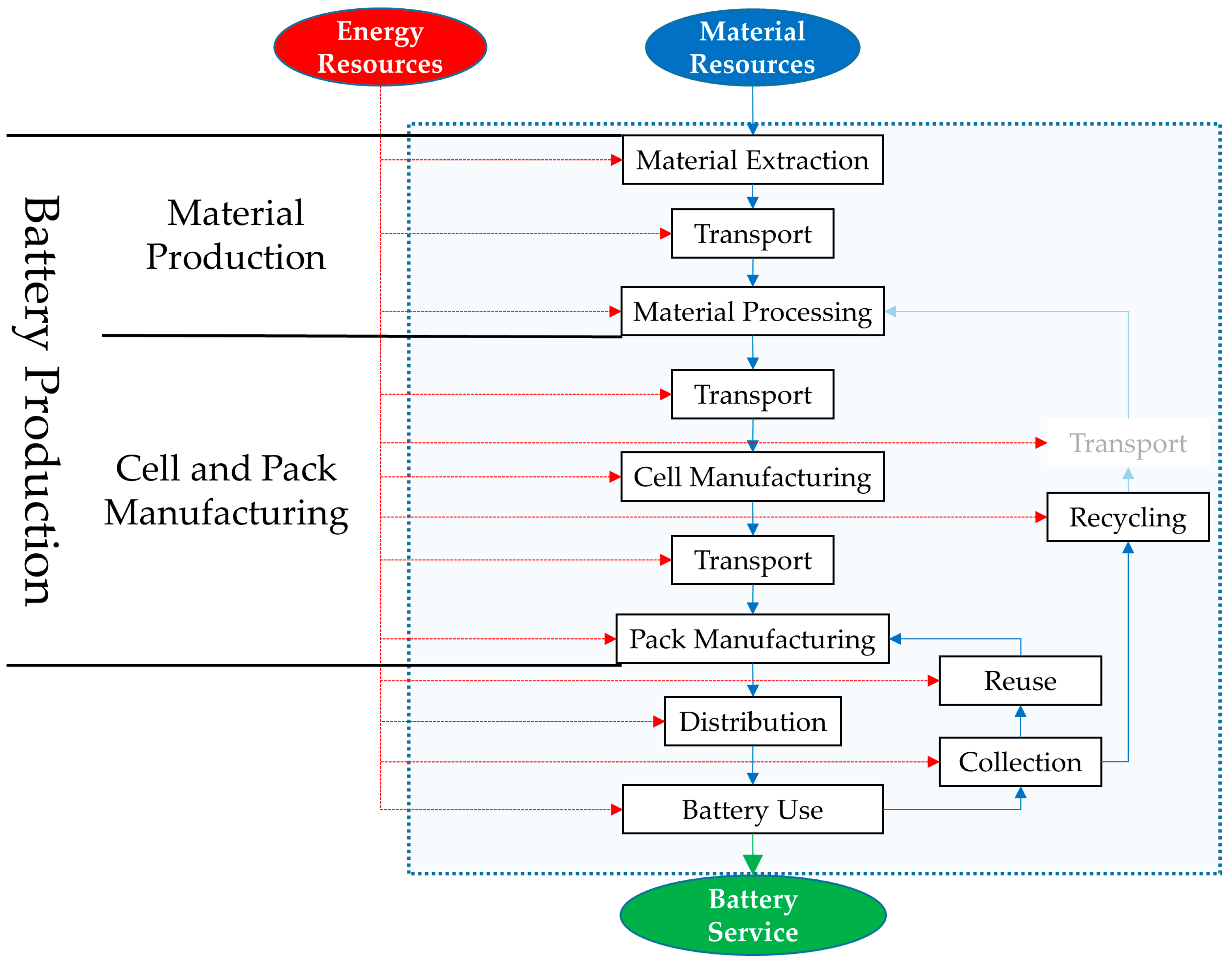


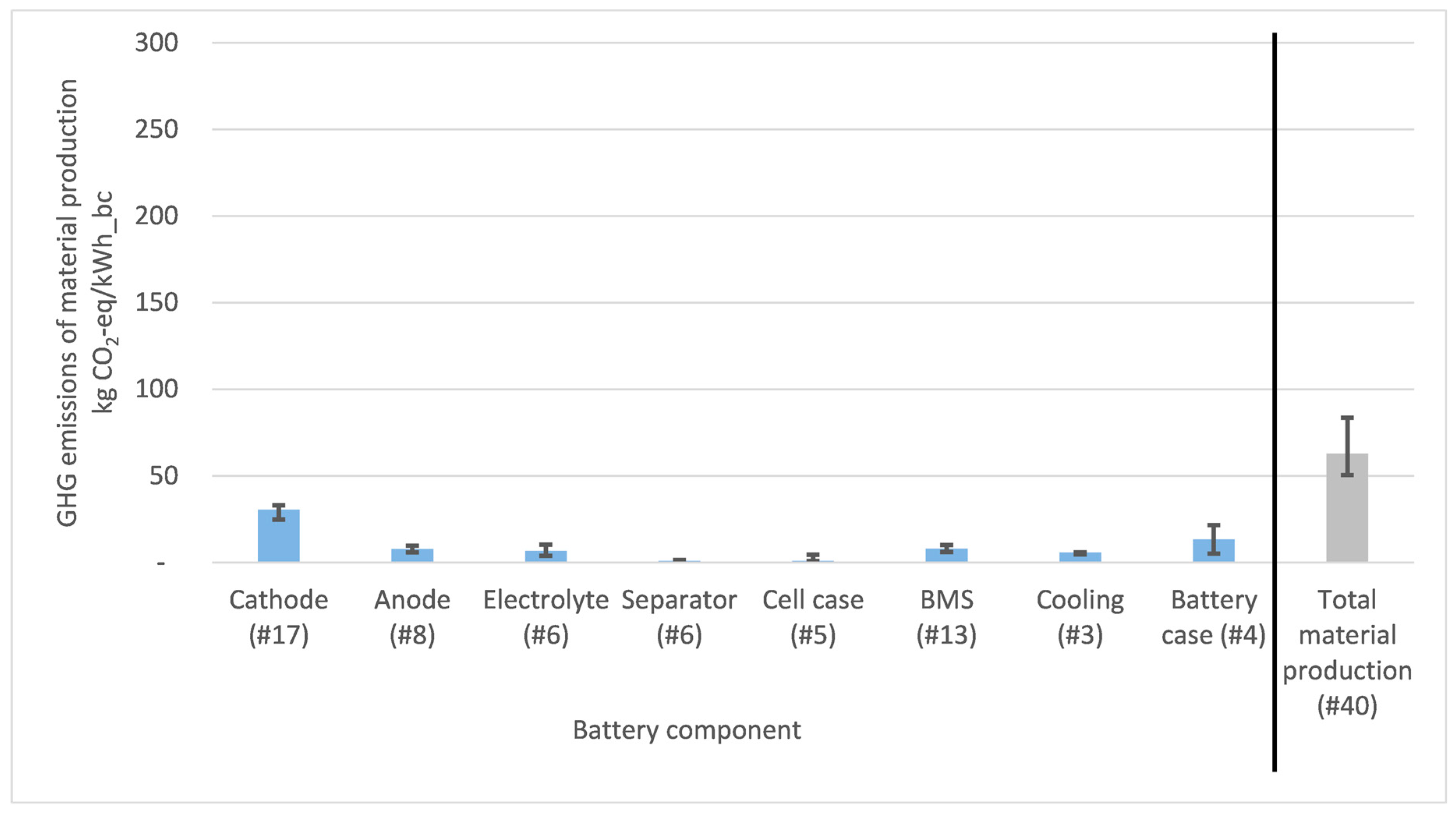
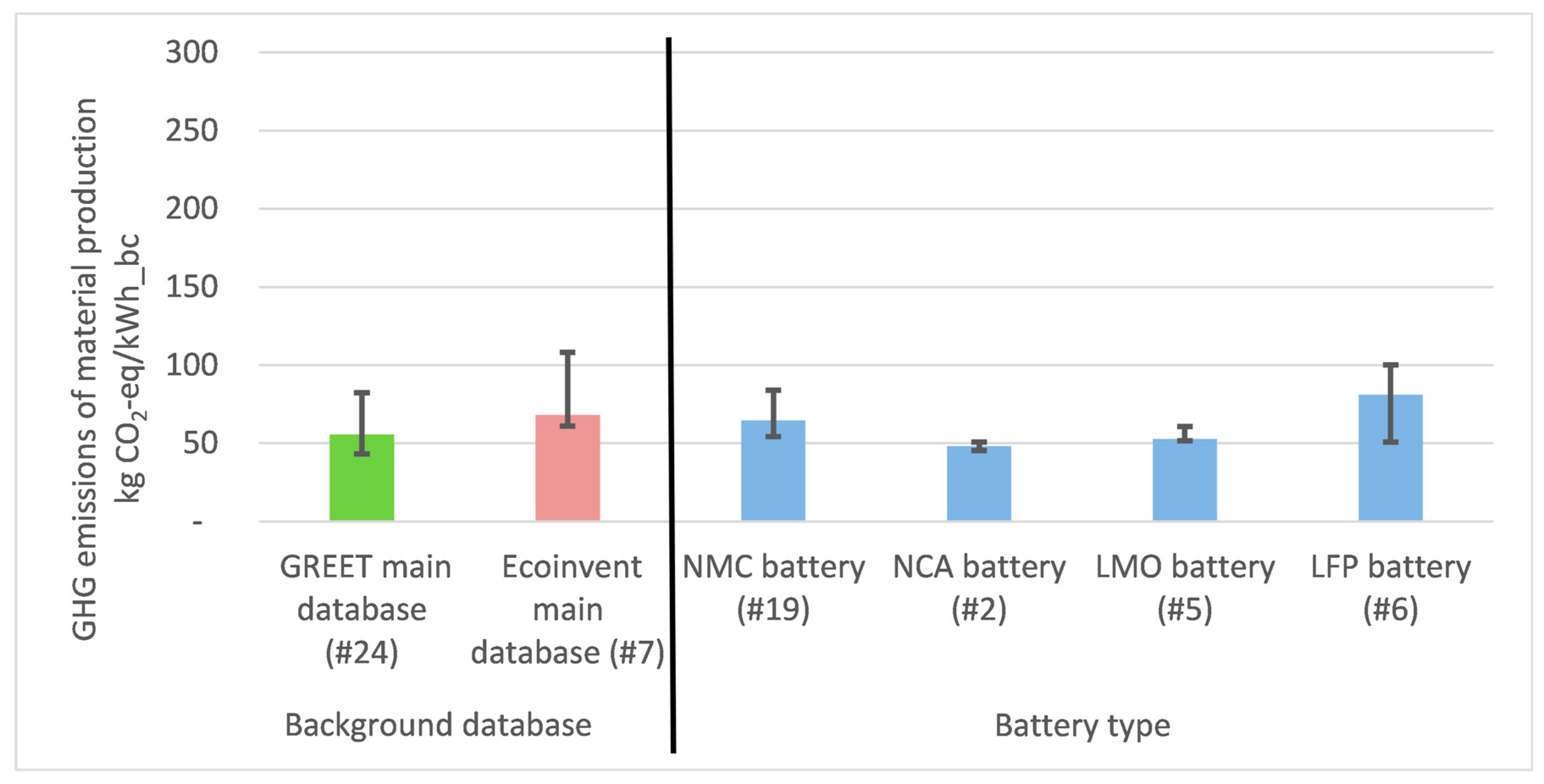
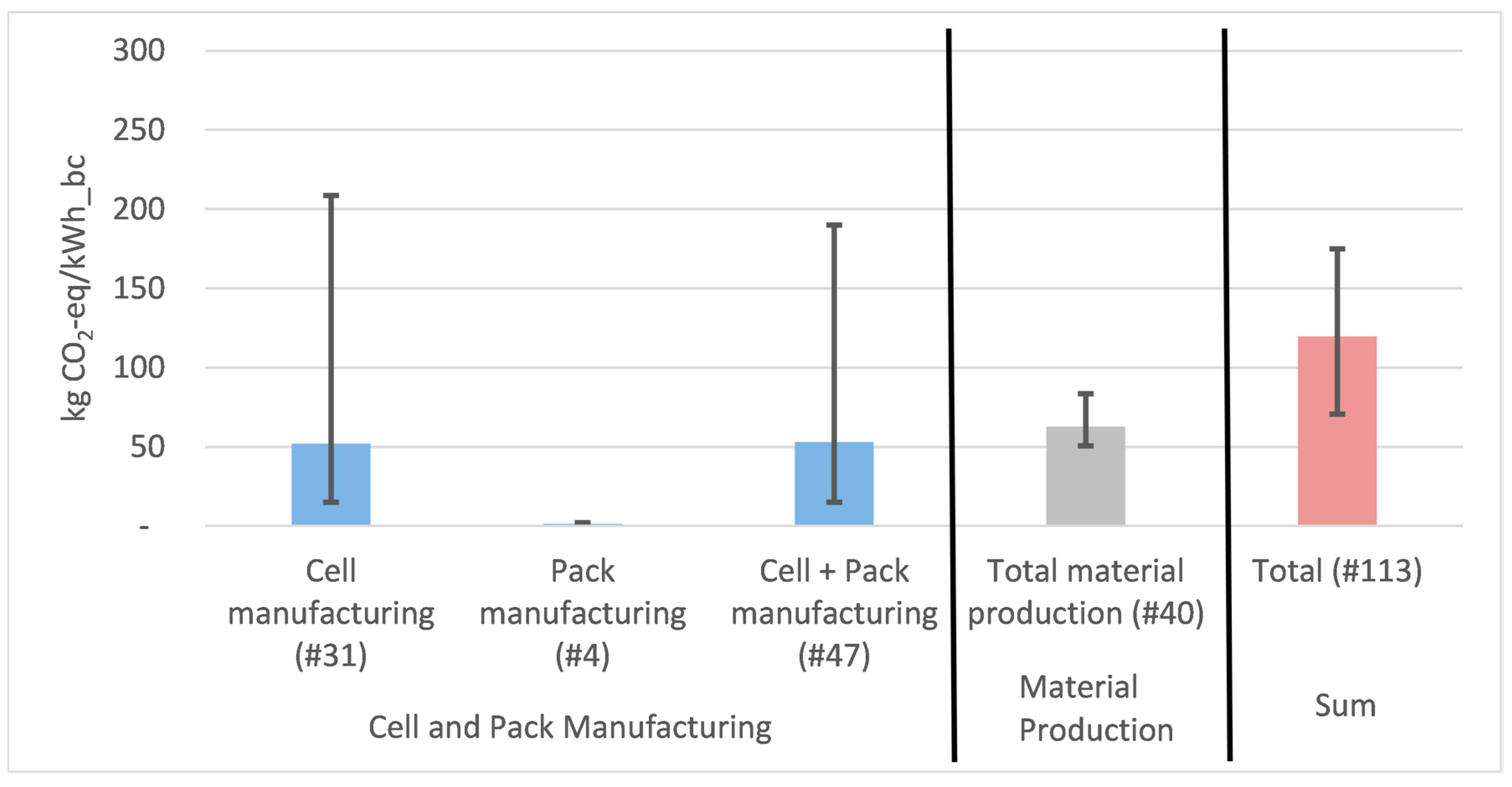
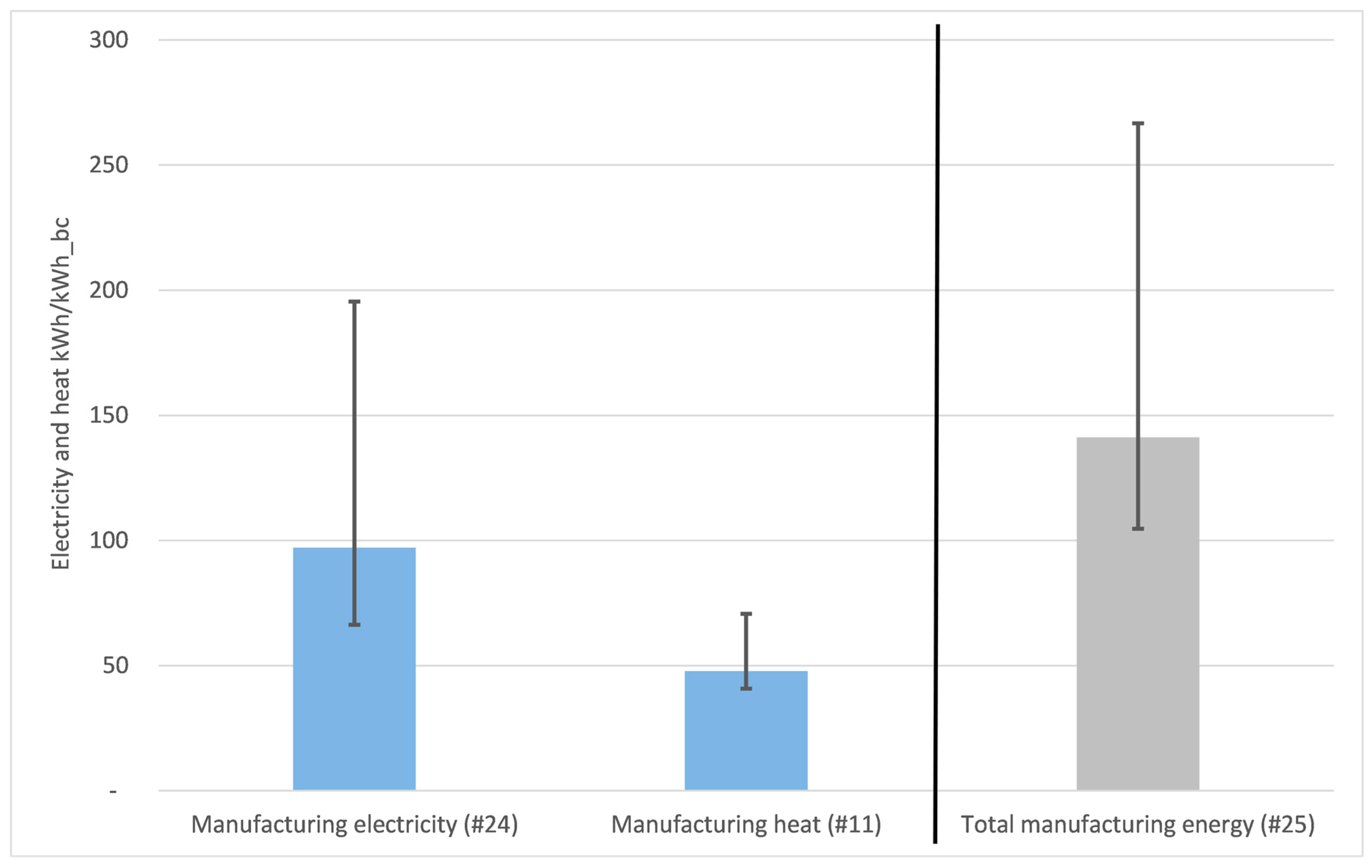
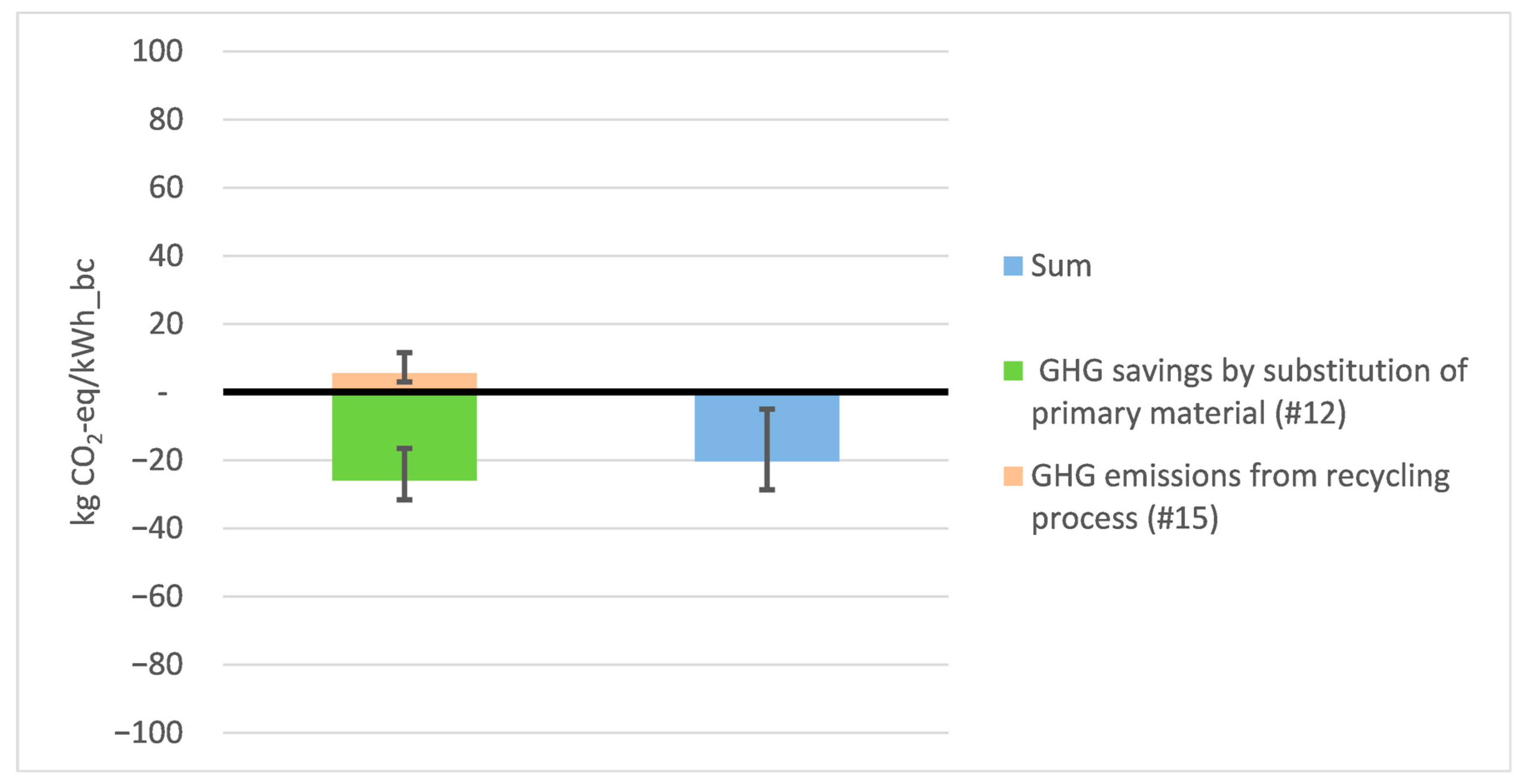
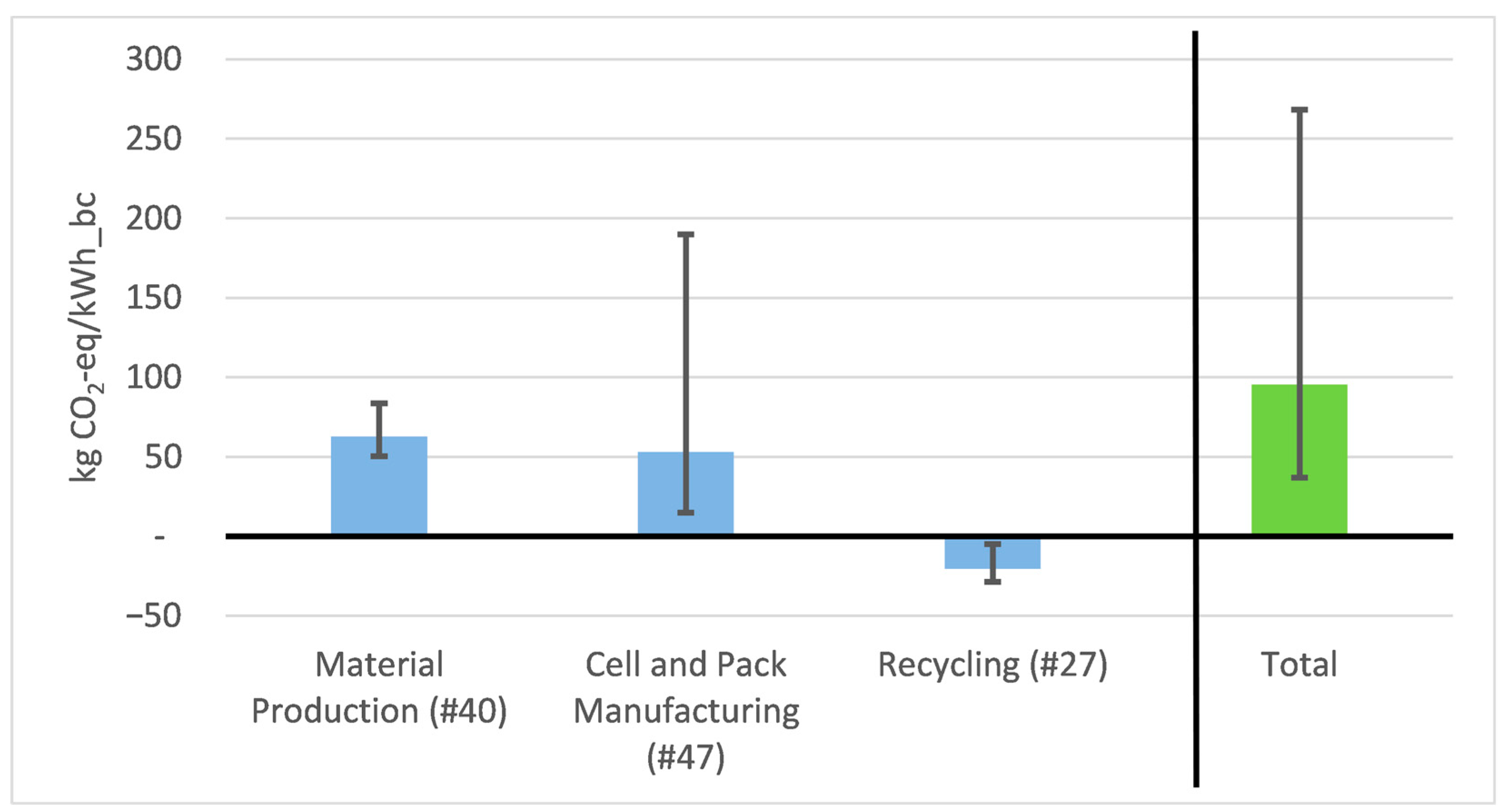
| Capacity [kWh] | 30 (25–40) | |
| Weight [kg] | 250 (170–440) | |
| Specific energy [Wh/kg] | 115 (100–135) | |
| Driving range per charge [km] | 190 (110–300) | |
| Lifetime | [km] | 180,000 (150,000–200,000) |
| [cycles] | 1850 (1100–3200) | |
| [years] | 13 (8–14) | |
| Ellingsen et al. (2014) | Dai et al. (2019) | |
|---|---|---|
| Production scale | Pilot plant, <1 GWh/a | Industrial plant, 2 GWh/a |
| Energy demand | 163–644 kWh/kWh_bc | 47 kWh/kWh_bc |
| Of which is electricity | 100% electricity; from East Asian mix (46% coal) | 18% electricity; from US mix (32.7% coal) |
| Of which is heat | - | 82% heat from natural gas |
| GHG Emissions of Battery Production | Battery Pack Capacity | Lifetime Battery | GHG Emissions | |
|---|---|---|---|---|
| [kg CO2-eq/kWh] | [kWh] | [km] | g CO2-eq/km | |
| Q25%-quantile | 70 | 25 | 200,000 | 9 |
| Median | 120 | 30 | 180,000 | 20 |
| Q75%-quantile | 175 | 40 | 150,000 | 47 |
Publisher’s Note: MDPI stays neutral with regard to jurisdictional claims in published maps and institutional affiliations. |
© 2020 by the authors. Licensee MDPI, Basel, Switzerland. This article is an open access article distributed under the terms and conditions of the Creative Commons Attribution (CC BY) license (http://creativecommons.org/licenses/by/4.0/).
Share and Cite
Aichberger, C.; Jungmeier, G. Environmental Life Cycle Impacts of Automotive Batteries Based on a Literature Review. Energies 2020, 13, 6345. https://doi.org/10.3390/en13236345
Aichberger C, Jungmeier G. Environmental Life Cycle Impacts of Automotive Batteries Based on a Literature Review. Energies. 2020; 13(23):6345. https://doi.org/10.3390/en13236345
Chicago/Turabian StyleAichberger, Christian, and Gerfried Jungmeier. 2020. "Environmental Life Cycle Impacts of Automotive Batteries Based on a Literature Review" Energies 13, no. 23: 6345. https://doi.org/10.3390/en13236345
APA StyleAichberger, C., & Jungmeier, G. (2020). Environmental Life Cycle Impacts of Automotive Batteries Based on a Literature Review. Energies, 13(23), 6345. https://doi.org/10.3390/en13236345






